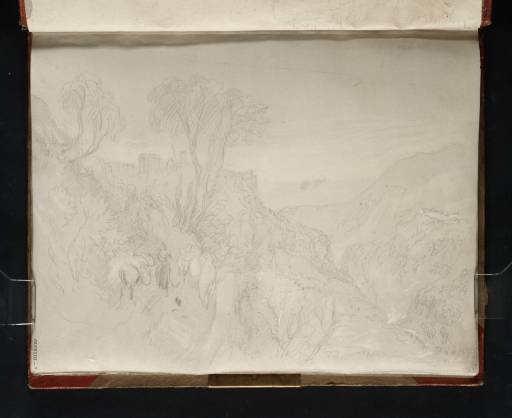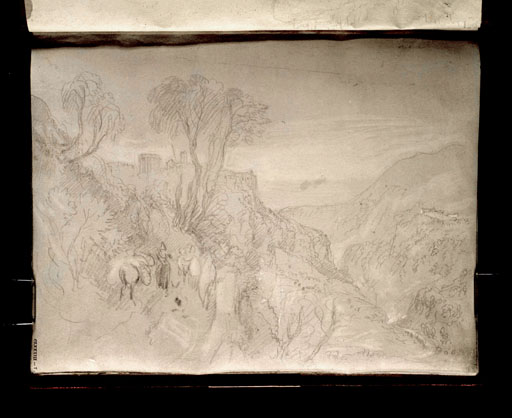Joseph Mallord William Turner View of Tivoli from Monte Catillo, with the So-Called Temple of Vesta 1819
Image 1 of 2
Joseph Mallord William Turner,
View of Tivoli from Monte Catillo, with the So-Called Temple of Vesta
1819
Joseph Mallord William Turner 1775–1851
Folio 2 Recto:
View of Tivoli from Monte Catillo, with the So-Called Temple of Vesta 1819
D15468
Turner Bequest CLXXXIII 2
Turner Bequest CLXXXIII 2
Pencil and grey watercolour wash on white wove paper, 200 x 253 mm
Inscribed by ?John Ruskin in pencil ‘2’ bottom left
Stamped in black ‘CLXXXIII 2’ bottom left, descending left-hand edge
Inscribed by ?John Ruskin in pencil ‘2’ bottom left
Stamped in black ‘CLXXXIII 2’ bottom left, descending left-hand edge
Accepted by the nation as part of the Turner Bequest 1856
Exhibition history
1878
[Oxford Loan Collection], University of Oxford, 1878–1916 (109 and 84b).
References
1878
Catalogue of Sketches by Turner Lent by The Trustees of the National Gallery to the Ruskin Drawing School, Oxford, London 1878, nos.109 (1st edition), 84b (2nd edition), as ‘Tivoli: The Groves of the Sybil’.
1904
E.T. Cook and Alexander Wedderburn (eds.), Library Edition: The Works of John Ruskin: Volume XIII: Turner: The Harbours of England; Catalogues and Notes, London 1904, no.84, p.564, as ‘Tivoli. The Groves of the Sybil’.
1909
A.J. Finberg, A Complete Inventory of the Drawings of the Turner Bequest, London 1909, vol.I, p.540, as ‘Groves of the Sybil. (Oxford, 109–84b)’.
1984
Cecilia Powell, ‘Turner on Classic Ground: His Visits to Central and Southern Italy and Related Paintings and Drawings’, unpublished Ph.D thesis, Courtauld Institute of Art, University of London 1984, p.174 note 19, reproduced pl.100, as ‘Tivoli’.
1987
Cecilia Powell, Turner in the South: Rome, Naples, Florence, New Haven and London 1987, pp.72, [77] note 17, reproduced pl.75, as ‘Tivoli’.
Turner sketched this view of Tivoli from a point on the present-day Via Quintilio Varo, on the lower slopes of Monte Catillo to the north-east of the town. In the middle distance on the left is one of Tivoli’s most famous landmarks, the silhouette of the so-called Temple of Vesta, a circular structure dating from the first century BC, perched on the edge of the steep gorge. Immediately adjacent is the so-called Temple of the Sibyl, a rectangular ruin which until the end of the nineteenth century was incorporated within the Church of San Giorgio. On the right-hand side of the composition is the river valley to the north of Tivoli with the course of the River Aniene winding west towards Rome. On the opposite slopes of the gorge can be seen the convent of San Antonio, also known as the Villa d’Orazio (Villa of Horace), described by Thomas Ashby as a ‘low, straggling white’ building.1
Turner made several sketches from this viewpoint, see folios 18, 22, 33, 34, 35, 78, 80 (D15484, D15488, D15500, D15501, D15502, D15550, D15552), as well as the Tivoli and Rome sketchbook (Tate D15000–D15005 and D15092; Turner Bequest 40–42 verso and 86a) and the Naples: Rome C. Studies sketchbook (Tate D16116 and D16118; Turner Bequest CLXXXVII 28 and 30). He also repeated the vista during his 1828 visit to Tivoli, see the Roman and French sketchbook (Tate D21912; Turner Bequest CCXXXVII 35a). The composition is similar to that of an early oil painting, Tivoli and the Roman Campagna circa 1798 (Tate, N05512),2 which was itself based upon a version of a picture by the eighteenth-century Welsh artist, Richard Wilson (1713–1782), for example, Temple of the Sibyl and the Roman Campagna circa 1765–70 (Tate, T01706).
Like many drawings within this sketchbook, the composition has been executed over a washed grey background. Turner has created highlights within the work by scratching, rubbing or lifting out the wash to reveal the white paper beneath, principally to create the lightness of the sky above the horizon. Freely drawn looping lines have been used to describe the wooded, rocky landscape, whilst areas of shadow have been indicated with vigorous hatching and shading. In the bottom left-hand corner there is a small figurative group, including a donkey or pony laden with sacks.
Verso:
Blank, except for traces of grey watercolour wash
Inscribed by ?John Ruskin in red ink ‘346’ bottom left, and by an unknown hand in pencil ‘85’ centre
Blank, except for traces of grey watercolour wash
Inscribed by ?John Ruskin in red ink ‘346’ bottom left, and by an unknown hand in pencil ‘85’ centre
Nicola Moorby
February 2010
How to cite
Nicola Moorby, ‘View of Tivoli from Monte Catillo, with the So-Called Temple of Vesta 1819 by Joseph Mallord William Turner’, catalogue entry, February 2010, in David Blayney Brown (ed.), J.M.W. Turner: Sketchbooks, Drawings and Watercolours, Tate Research Publication, December 2012, https://www


